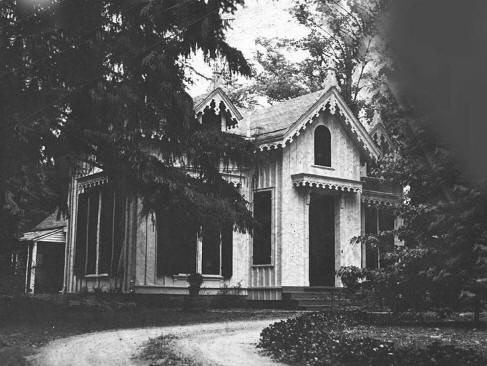“Tuliphurst”
The Noble Butler Years 1854-1864
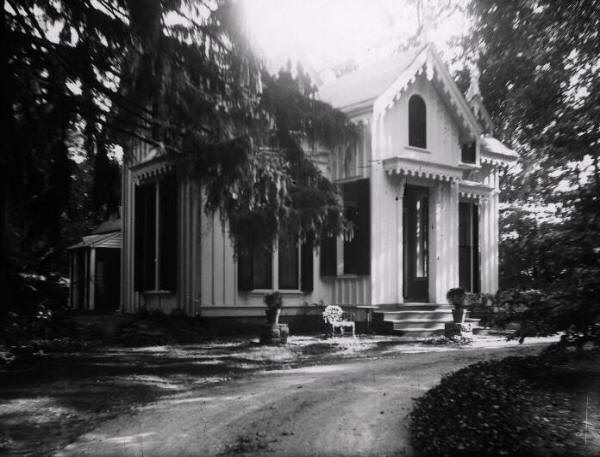
Tuliphurst, early photo by Kate Matthews
During Pewee Valley’s “Little Colonel” era, Tuliphurst (115 LaGrange Road) was the summer home to prominent Louisville businessman Woodford H. Dulaney, who added the landmark Gothic Revival front wing in 1865. Some accounts suggest that members of the Dulaney family served as models for characters in the “Little Colonel” stories. Tuliphurst’s first owner was grammarian and textbook author Noble Butler. According to local legend, this home was also where Pewee Valley received its unusual name ca. 1856, an event memorialized by another Pewee novelist, Catherine Anne Warfield, in the poem excerpted below.
According to “Historic Pewee Valley,” Tuliphurst was built in two principal stages. Noble Butler built the original modest two-room cottage about 1854. In 1864, it was purchased by Woodford H. Dulaney and he added a fine Gothic Revival front wing about 1865.
Tuliphurst is historically important to Pewee Valley, because it was here that the town received its very unusual name. From “History & Families Oldham County, Kentucky: The First Century 1824-1924,” pages 243-244:
…by the late 1860s, the name of the area had been changed from Smith’s Depot to Pewee Valley, as recounted in the following poem, Pewee Valley, by C.A. Warfield, first printed in 1873.
A band of settlers had chosen a glade
Deeply embowed in beechen shade;
Weary of turmoil, of crowds, of strife,
They longed for the peace of a rural life.
They reared their dwellings with porch and hall;
Volumes and pictures on ev’ry wall;
While vines and blossoms of many a dye
Made gardens fit for a poet’s eye.
“What shall we call our valley fair?”
Said the poet one day, with the golden hair;
“Our homes are garnished, our trees are set.
But a name is a thing that is wanting yet.”
Then they called a council of young and old,
And every settler was soon enrolled;
A motley group, yet of one accord
As each one rejected his neighbor’s word.
For every settler a name had brought,
Some amid ancient lore had sought,
But the sounding titles of Greece and Rome
Seemed strange in that peaceful, rural home.
Grand Indian names some bore in mind,
Strong and deep as the lurking wind,
But they bore strange memories of whoop and yell,
and were quite too fierce for that sylvan dell.
Others had gathered from Spain and France,
High sounding titles of past romance;
And some had wished to enshrine the spot
With the lovely legends of Walter Scott.
All failed to please, and a silent cloud
Hung o’er the disappointed crowd;
When suddenly from a tiny throat
Burst forth an unexpected, suggestive note.
On the ledge of the porch where council met,
Where his mate on her speckled eggs was set,
While he hovered above her in loving glee–
A self-called member proposed “Pee Wee.”
A sound of greeting — a glad “All Hail!”
It seemed from the genies of the vale.
And the dark browed student said to the bird
“You have supplied the wanted word.”
Then the council arose with one acclaim
And Pewee Valley became a name.
Still the small, gray bird with marital nest
“Neath every roof is a welcome guest.”
Legend has it that for years, residents wanted a name for their own town that better exuded its charm than did Smith’s Depot. One day several town leaders met at Tuliphurst, the home of Noble Butler, who had written the standard grammar book used in Kentucky schools. A native bird, the Eastern Wood Pewee, accompanied their conversation with its song, inspiring the group to adopt Pewee Valley as the town’s name.

Eastern Wood Pewee
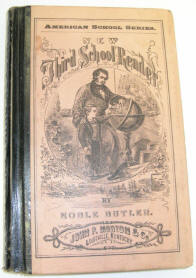 Noble Butler is profiled in the “Biographical Encyclopedia of Kentucky of Dead and Living Men of the Nineteenth Century” published in 1877. Excerpts from that profile:
Noble Butler is profiled in the “Biographical Encyclopedia of Kentucky of Dead and Living Men of the Nineteenth Century” published in 1877. Excerpts from that profile:
BUTLER, PROF. NOBLE, A.M., LL.D., was born July 17, 1810, in Washington County, Pennsylvania, and was named after his great-grandfather…His early education was commenced in a log school-house in Jefferson County, Indiana to which State his father had moved when his son was seven years of age. He was graduated at Hanover College, Hanover, Indiana, in 1836; was immediately afterward appointed Professor of Greek and Latin in that institution; held the position until 1839, when he was appointed to the same chair in the University of Louisville, and removed to that city, where he has since resided, and taken rank among the most accomplished scholars and first educators of the country. Many years ago, at the request of the Louisville publishers, Morton and Griswold, he prepared an English Grammar, which became very popular throughout Kentucky, and was very favorably received and extensively used as a text-book in schools over the country. He has recently published his “Practical and Critical Grammar,” which has received the highest encomiums from teachers throughout the United States and Canada and in Europe. Some years ago he was employed to revise S.G. Goodrich’s series of school Readers, which were greatly improved and known as “Noble Butler’s Goodrich’s Readers.” He subsequently produced “Butler’s Readers,” an independent series…Professor Butler was married, in 1836, to Lucinda Harney, sister of the late John H. Harney, who was many years editor of the Louisville Democrat. They have five children….
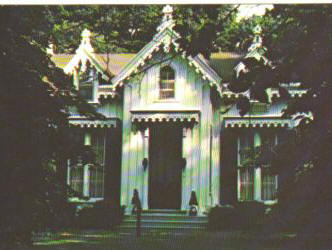
Tuliphurst, “home of Noble Butler
(early postcard)
The Dulaney Years and the Little Colonel Years
1865 – Present
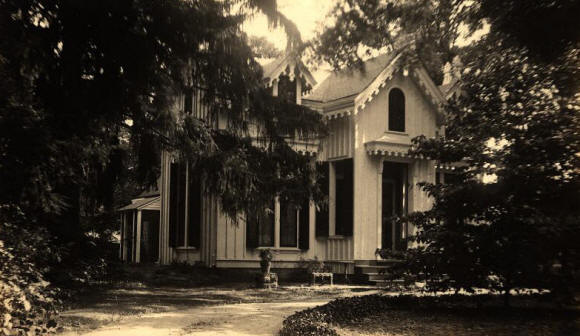
Tuliphurst, early photo by Kate Matthews
During Pewee Valley’s Annie Fellows Johnston era, Tuliphurst was owned by Woodford H. Dulaney, a wealthy Louisville businessman and “prominent capitalist” who purchased it from Noble Butler as a summer residence.
At this point, we do not know if any members of the Dulaney family served as models for characters in the Little Colonel stories; however, in her memoirs, “Sunshine and Shadow,” the Reverend Peyton Hoge’s daughter, Cary Hoge Mead, implies that Annie Fellows Johnston included them in her books:
…I had been given a copy of “The Giant Scissors” and one or two other books of hers two or three years before we moved from Louisville, and as soon as we moved to Pewee Valley, I began hearing about, and reading, “The Little Colonel Books.” These were about all the people who lived there — the Lawtons, Miss Fanny, the Dulaneys, the Matthews with Hattie Cochran, the center of them all as “The Little Colonel”…
Woodford H. Dulaney’s obituary, published December 20, 1902 in the “Courier-Journal” tells us much about the Dulaney family:
Woodford Hector Dulaney, for many years one of Louisville’s foremost capitalists, besides being president of the Kentucky Commission for the World’s Columbian Exposition held at Chicago in 1893, died yesterday (December 19, 1902) at 1:30 o’clock at his residence, 720 West Broadway. The illness to which he finally succumbed dates back to a year ago this month, when he contracted a severe case of grip, which was prevalent at that time. Though at intervals he managed to regain something of his former strength, he was frequently ill and months ago the members of his family and his friends realized that the end could not be far away. The immediate cause of Mr. Dulaney’s death was inflammation of the bladder, which developed about ten days ago. Mr. Dulaney was perfectly conscious and able to converse with those about him until shortly before the end. He sank as peacefully as if falling to sleep and died to all appearances without suffering. With him were two of his daughters, Mrs. Albert S. Willis and Miss May Dulaney, and his son, W. Hector Dulaney. His third daughter, Mrs. Judson Clements, of Rome, Ga., was unable to be here on account of having an ill child.
Only Recently Retired
Mr. Dulaney was eighty-one years of age, and of course the infirmities of old age told heavily upon him when his health was broken by the first attack a year ago. He bore up under his failing health with great patience and almost to the last took a keen interest and an active hand in the conduct of his affairs. It was not two years ago when he severed his last connection with active business life. This was his resignation from the directorate of the National Bank of Kentucky, in which he had held a place continuously for upward of twenty-five years. Until his illness a year ago Mr. Dulaney had known but little ill health throughout the whole course of his life. The members of his family say that they cannot remember when he was ill before. Always a temperate man, he build up a constitution of iron.
After rallying from the worst of his last winter’s attack of the grip, he went to Palm Beach in the hope of regaining his strength. The change, however, did not appear to be of any special benefit to him, and he continued to slowly lose his remaining strength. After remaining at Palm Beach until shortly after March 1, he returned home. A severe attack of rheumatism in the lower limbs which he first sustained while in Florida continued to develop after his arrival here. The return trip told heavily upon him, and it was all he could do to get home. From that time he was confined to his home steadily, with the exception of a few short intervals, until about July 1. He and his family then removed to their summer home in Pewee Valley, and during August and September he began to show slight signs of improvement. With the return of winter, he began to be troubled once more with rheumatic attacks, and complications followed. On account of his illness the family did not move from the city from their country home until December 4. Since then, Mr. Dulaney grew steadily worse until death finally came to his relief.
Prominent Business Man
Mr. Dulaney has been closely identified with the city’s business interests, both financial and mercantile for fully half a century. He made his first fortune in the dry goods business before the war, and had always held large interest in two or three of the city’s most prominent banking institutions and bought a great deal of real estate, much of which he improved and sold at a profit. At the time of his death he was one of Louisville’s heaviest owners of land and houses. His rent roll was probably one of the largest in the city. He was a promoter and official of one railroad. Besides these greater affairs he always had in hand a number of smaller interests, and always gave every item of his business that minute attention which marks the man with a genius for business.
A Strong Democrat
Though possessing an unusually wide circle of acquaintances he belonged to no club or fraternity. Quiet and unassuming, he always made his own fireside his club, though from the first was popular with all classes of men in business. He took an active interest in both city and national politics, being a strong Democrat. He was especially interested in municipal affairs, and with his true business instincts possessed many excellent ideas upon the administration of civic affairs. Only once was he a candidate for municipal office. It was when he was elected to the Board of Aldermen a number of years ago.
Work for Columbian Exposition
Mr. Dulaney probably attained his greatest prominence in the world of affairs by his administration of the Kentucky Commission to the World’s Columbian Exposition. This board was appointed by former Governor Brown in 1892, and Mr Dulaney was selected by his associates as its chief officer. Associated with him on the board were Commissioner of Internal Revenue John W. Yerkes, former Congressman Clardy and Judge J.D. Black. Notwithstanding many errors and delays of legislation, Kentucky’s showing at the exposition was pronounced by all as an unqualified success. This success was largely due to Mr. Dulaney’s untiring work and his extraordinary ability to conduct such an enterprise. On account of certain litigation, the cause for which originated during the progress of the exposition, the commission was long delayed making its final report to the Governor. This report was presented about a year ago and in a straightforward manner set forth the great work that had been accomplished. It also turned over to the State about $25,000 of the appropriation which the Legislature had allowed it with which to carry on work. So well had the affairs been conducted that Mr. Dulaney had been able to save $25,000 of the State’s money and return it to the treasury. This matter was commented upon by the press of the country, and upon Mr. Dulaney was conferred all the praise his work so well merited.
Surviving Relatives
Mr. Dulaney leave four children and a brother and sister, both older than himself. His wife died several years ago. His living children are Mrs. Albert S. Willis, the widow of the late Hon. Albert S. Willis, former member of Congress and Minister to Hawaii; Mrs. Judson Clements, wife of former Congressman Clements, of Georgia and now a member of the Interstate Commerce Commission; W. Hector Dulaney of this city; and Miss May Dulaney. His brother, Robert L. Dulaney, makes his home at Marshall, Ill. His sister is Miss Lizzie Dulaney, of this city. In all Mr. Dulaney had ten children, six of whom are dead. They were Margaret Josephine, who died in 1879; Robert L., who died in 1899; Benjamin Cawthon, who died in 1899; and Charles Cawthon, Maggie Woodford and Mary Maud, who died in infancy Mr. Dulaney leaves six grandchildren. Albert Willis, Jr., now at Yale University; Henrietta Dulaney, daughter of W. Hector Dulaney; Woodford H. Dulaney, son of the late Robert Dulaney, and Clementine Elizabeth, Margaret Dulaney and Mark Park Clements, daughter of Mrs. Judson Clements. Aside from those now living, Mr. Dulaney had another sister and a brother. They were Mary E., wife of Dr. J.W. Martin, of Brookhaven, Miss., who died in 1880, and Charles F. Dulaney, who died more than thirty years ago in California.
Virginian By Birth
Mr. Dulaney was a Virginian by birth, being born in Loudoun country, which is in the northern part of that state. His parents were Zachariah and Mary Eleanor Braden Dulaney, who came form families which had long made their homes in the tide-water district of Virginia. They were of Irish descent, their ancestors having come over to Virginia in 1700 at the period of political agitation which resulted in the immigration to America of a large number of the best citizens of Ireland. They settled first at Alexandria, near Washington, which was then the principal seaport of the State. Mr. Dulaney received his early education at the country schools in Loudoun County and commenced his commercial career at the age of fourteen as a clerk at a dry goods and grocery store in the village of Waterford, Va. He soon attracted attention to himself by his ability and secured not long afterward a better position in Leesburg, the county city of Loudoun county. Later he went to Washington, D.C., continuing in commercial pursuits.
Came To Louisville At Early Age
In the nineteenth year of his age he came to Louisville and landed here in 1840 without a friend and with no capital. Through letters he had with him he succeeded in obtaining a clerkship in the dry goods house of Sewell & Company, and shortly afterward won a still better position in the house of J.L. Raphael, known as “Maison d’Or.” It was then regarded as one of the largest and best establishments of its kind in the city. At that time the store was located on Main Street, between Fourth and Fifth. After few years in this firm, Mr. Raphael sold out his interests to Mr. Dulaney and two other clerks in his employ named Mark and Downs. These three conducted the business for a number of years under the firm name of Mark, Dulaney & Downs. In 1851 Mr. Dulaney married Miss Margaret Cawthon. For recreation from his close application to business he took a trip to Europe, remaining abroad for about eighteen months. He was accompanied by his wife and daughter. He returned to the city in about 1859 and continued to address himself to his large private interests. One of his principal enterprises was his management of the estate of Benjamin Cawthon, his father-in-law, who had died a few years before, naming him as executor of his will. Mr. Cawthon was one of Louisville’s wealthiest citizens, leaving large and varied interests, which required a number of years to be properly settled.
Held Prominent Positions
In spite of the heavy demand made upon his time by his many private affairs he was called upon by his fellow citizens to take an active part in the city government. However, he would only consent to run for the General Council, and he represented that body in 1861 and again in 1866 and 1867. During the progress of the Civil War he was always regarded as a Southern sympathizer, though he never took any active part in aiding the Confederacy and lived without bitterness or friction with the Union sympathizers of the city. Mr. Dulaney was a member of the first directorate of the Elizabethtown and Paducah railroad, later a part of the old Chesapeake and Ohio Southwestern and now owned by the Illinois Central. In 1870, he became president of the road and in 1874 he was elected president of the Cumberland and Ohio Railway Company. Upward of twenty years ago he became one of the board of managers of the Cave Hill Cemetery and held this position at the time of his death. For a short period of time he was president of the Bank of Commerce.
Many of Mr. Dulaney’s old business associates are dead. Among those closest to him during his long career were the late Thomas Barret, president of the Bank of Kentucky, in which Mr. Dulaney was a director for several years; the late S.S. Mark, who was his partner in the dry goods business before the war; G.F. Downs, also of that firm; John T. Moore, formerly of this city but now making his home in Chicago; George W. Morris and a number of others. His brother-in-law, Benjamin Cawthon, who died in 1899, was always closely associated with Mr. Dulaney, both in business and socially.
Mr. Dulaney has made his home at the present family residence, 720 West Broadway, since 1872. Prior to that time for a number of years he occupied a smaller residence in the same block on Broadway. Before that he lived on Chestnut Street.
Mr. Dulaney has always been regarded as one of the wealthiest of Louisville men for many years. He leaves an estate, the value of which is estimated at being considerably in excess of $1,000,000. Most of this property is in houses and lots. He owned about 160 acres of land near the end of Sixteenth street, besides many houses, both residences and business blocks.
Member of St. Paul’s Church
Since shortly after his location in Louisville, Mr. Dulaney was a member of St. Paul’s Episcopal Church. He was for many years a regular attendant when the church was located at Sixth and Walnut streets, and continued his active membership after the removal of the church to Fourth Avenue and Victoria Place. He was a liberal giver to charity.
Two of Woodford H. Dulaney’s children married and moved away, although Mrs. Albert S. Willis, the widow of the late Hon. Albert S. Willis, former Congressman and Minister to Hawaii, returned to Louisville at some point. Two others, Miss May Dulaney and W. Hector Dulaney, remained in Louisville. Miss May Dulaney never married. She died on July 10, 1942:
Miss May Dulaney, 76, died at 2:50 a.m. Thursday at her home in The Puritan. She had been ill two years. She was born in the residence built by her father, the late W.H. Dulaney, Sr., at 8th & Broadway, now the Weisworth Hotel. She had been active in St. James Episcopal Church many years. Survivors are her sisters, Mrs. Albert S. Willis and Mrs. Judson C. Clements, Washington; nephews Woodford H. Dulaney and Albert S. Willis, and nieces Miss Claudine Clements, Miss Margaret Clements and Miss Mary Park Clements, all of Washington, and Mrs. Allen Harvey. ..Burial in Cave Hill Cemetery.
W. Hector Dulaney, Woodford Dulaney’s son, died in 1903.
Pewee Valley Town Historian Gin Chadouin recalls that both May Dulaney and her sister, Mrs. Willis, were living in Tuliphurst during her childhood.
Another child, Robert Lee Dulaney, married a Pewee Valley girl, Anna B. McAfee, who lived in a log cabin off of what is now Old Forest Road.
Given the fact that the first Woodford H. Dulaney served on the board of managers for Cave Hill Cemetery it is not surprising that most of the family is buried there, in Section P, Lot E. Woodford H. Dulaney’s will included the following provision:
I devise to Cave Hill Investment company one thousand dollars ($1,000) the interest on which shall be used for the perpetual care of my lot in Cave Hill Cemetery.
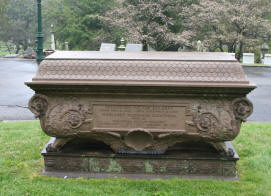
W.H. Dulaney grave in Cave Hill Cemetery
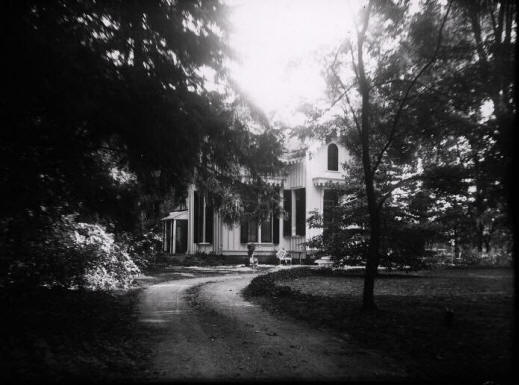
Tuliphurst, early photo by Kate Matthews
page by Donna Russell
